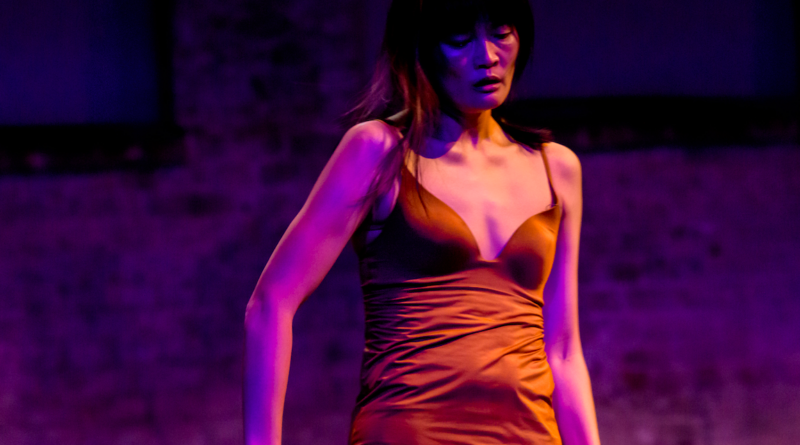INTERVIEW: Megumi Eda’s new dance piece explores the impact of war
Photo: Megumi Eda will perform in Please Cry at the La MaMa Moves! Dance Festival, April 25-27. Photo courtesy of Bernd Kumar / Provided by press rep with permission.
The La MaMa Moves! Dance Festival is back, and dancer/filmmaker Megumi Eda is set to present her new solo piece Please Cry, which explores several important issues, including intergenerational trauma, the reality of war and the hope for resilience, according to press notes. The U.S. premiere of the work kicks off Friday, April 25, and continues through Sunday, April 27, at The Club on the Lower East Side.
The piece, which is on a shared program with the work of Alexis Chartrand and Nic Gareiss, is deeply personal for Eda because it’s inspired by her grandmother’s past during World War II, according to an official news release for the show. As Eda performs, Reiko Yamada’s score provides fitting accompaniment.
Recently Hollywood Soapbox exchanged emails with Eda about Please Cry. As a choreographer, she has been creating works that are at the intersection of theater, dance and film. She has worked with everyone from the Hamburg Ballet to the Dutch National Ballet to the Rambert Dance Company. She was based in New York City for a while, working with Armitage Gone! Dance, and now she’s based in Berlin. Questions and answers have been slightly edited for style.
When did you realize that your grandmother’s history could be adapted to a dance piece?
It happened in phases. In 2003, I created a piece called 8:15, inspired by the clock at the Hiroshima Peace Memorial Museum, which stopped at 8:15 — the moment the bomb fell. It was also the year the Iraq War began, and I felt compelled to reflect on war, memory and trauma through dance. The Rambert Dance Company, where I was a member, sponsored the work, and I presented it then.
Later, after moving to the United States, a comment someone made made me feel naïve for addressing this subject, and I stopped speaking about it for a long time.
During the pandemic, Yoshiko Chuma invited me to participate in her Saturday Morning Live series, where I revisited 8:15. To my surprise, I received a very warm response. It made me feel like maybe I could return to this subject.
Then one day, I found an old photo of my grandmother in her military nurse uniform. I kind of knew she’d been a nurse during World War II, but somehow, the image made it real in a different way.
Later, I saw a documentary featuring a woman, nearly 90 years old, who had served as a military nurse — just like my grandmother. She spoke about her wartime experiences for the first time in over 70 years. What struck me wasn’t just her words, but her voice, the pauses, her eyes. I started to imagine: What if my grandmother had experienced similar things? What had she carried in silence?
This was when the idea for Please Cry took shape. I wanted to explore the unspoken, the gestures between words — the emotional residue — and express that through dance.
How does the work address the issue of intergenerational trauma?
Living as an immigrant in the West for over 30 years — now in Berlin — has shown me that the trauma of war is not merely a historical event, but an enduring legacy passed down through generations like an unbroken chain. This resonates deeply with my German peers, many of whom also carry the weight of war through their own family histories.
In Please Cry, I explore this inherited silence and emotional residue through movement, gesture and live video. It’s not about recreating specific events, but expressing the echoes of pain, resilience and memory that still live in the body — mine, and perhaps others’. The piece becomes a space where unspoken emotions can be seen, felt and maybe even released.
How do you incorporate live video into the performance?
Please Cry blends live dance with live film, following a choreographic format I’ve been developing since 2020. The work merges abstract movement with documentary-style filmmaking, producing a dreamy, cinematic atmosphere.
During the performance, I use a handheld phone camera on stage — what I call my “life tool” — to capture both close-ups of emotional expressions and wide shots in real time. These live images are transmitted wirelessly to a large screen, giving the audience a dual perspective: one intimate, the other expansive.
This setup allows me to be both dancer and filmmaker simultaneously. The camera becomes an extension of my body, responding to emotion, rhythm and memory in the moment.
As Kyung Joo Park noted in a 2023 review: “Eda performed while manipulating her cellphone as her life tool, with the video image transmitted and shown wirelessly on a large screen. This organic performance not only showcased her skills as a dancer but also explored the unique challenge of being a filmmaker in the same time and space.”
The word resilience is used in the press notes to describe the performance. Why was it important to include resilience as a theme?
I never set out to create a depressing piece. The grandmother I knew was cheerful, stylish, full of laughter and loved being around people. Even if she had experienced something similar to the woman in the documentary, I want to believe that humans have the ability to recover — that resilience is possible.
I also think the pain and anger we see in the world today, though deeply tragic, are still part of the larger universe — and they must not be repeated. I hope for a bright future for our children.
I’m not a historian or an expert, and I’ve never experienced war myself. Honestly, I often feel shy and hesitant to approach such a heavy subject. But through dance, I can explore that tension — between pain and hope, silence and expression. That’s where I believe resilience lives.
Do you feel a lot of pressure when you’re the only one on stage?
Yes and no. It took a lot of courage to present my own work using my own body. I’ve performed many solos in other people’s pieces, and I actually enjoy that — there’s a kind of freedom in being able to create and control the world on stage by myself. But in those cases, I’m not carrying the full weight of the work’s meaning or message.
With Please Cry, it’s different. This piece is deeply personal, and because it comes from my own history and emotions, I feel much more vulnerable. So yes, I do feel nervous — more than usual.
Will this U.S. premiere be similar to the world premiere, or have changes been made?
This U.S. premiere will be a little different. My collaborator, Reiko Yamada, who composed and performed the live music, won’t be able to attend — so I’ll be using recorded music and new compositions to present it as a complete solo piece.
Emotionally, it also feels very different. I’m performing this work in the U.S., where, over 20 years ago, I decided to stop talking about this topic. Coming back to it now brings up complicated feelings. To be honest, I’m still unsure — but maybe that uncertainty is part of what gives this version its own truth. I hope.
By John Soltes / Publisher / John@HollywoodSoapbox.com
Please Cry, choreographed and performed by Megumi Eda, will play the La MaMa Moves! Dance Festival, April 25-27. Performances take place at The Club on the Lower East Side of Manhattan. Click here for more information and tickets.

